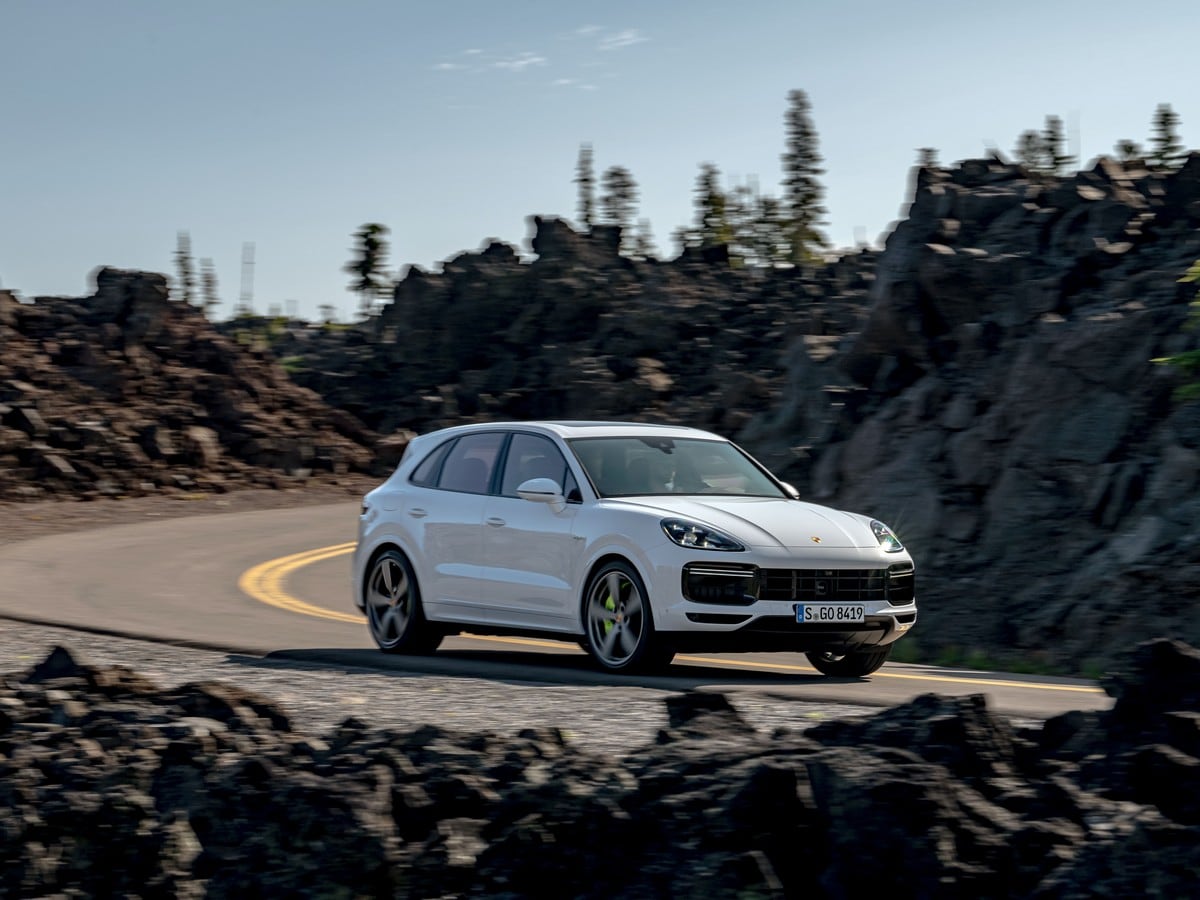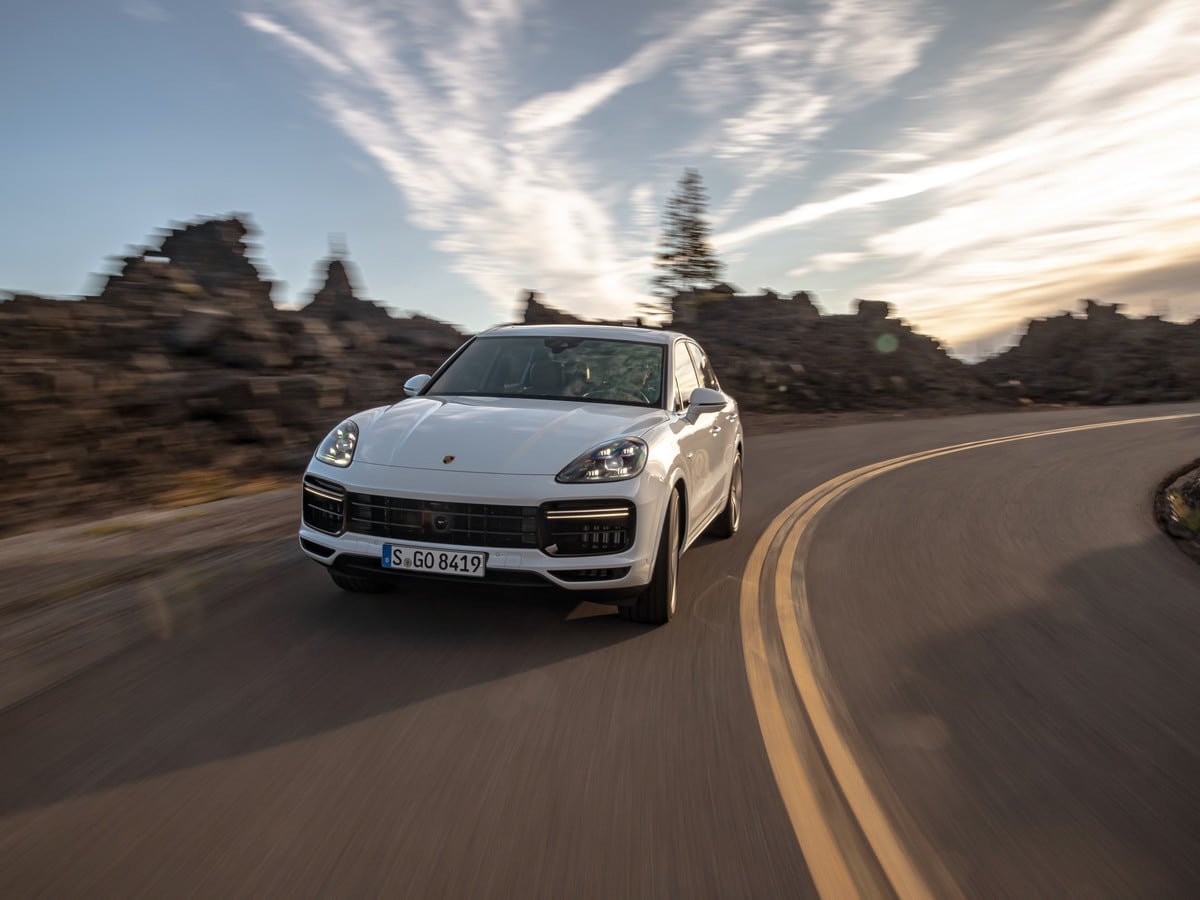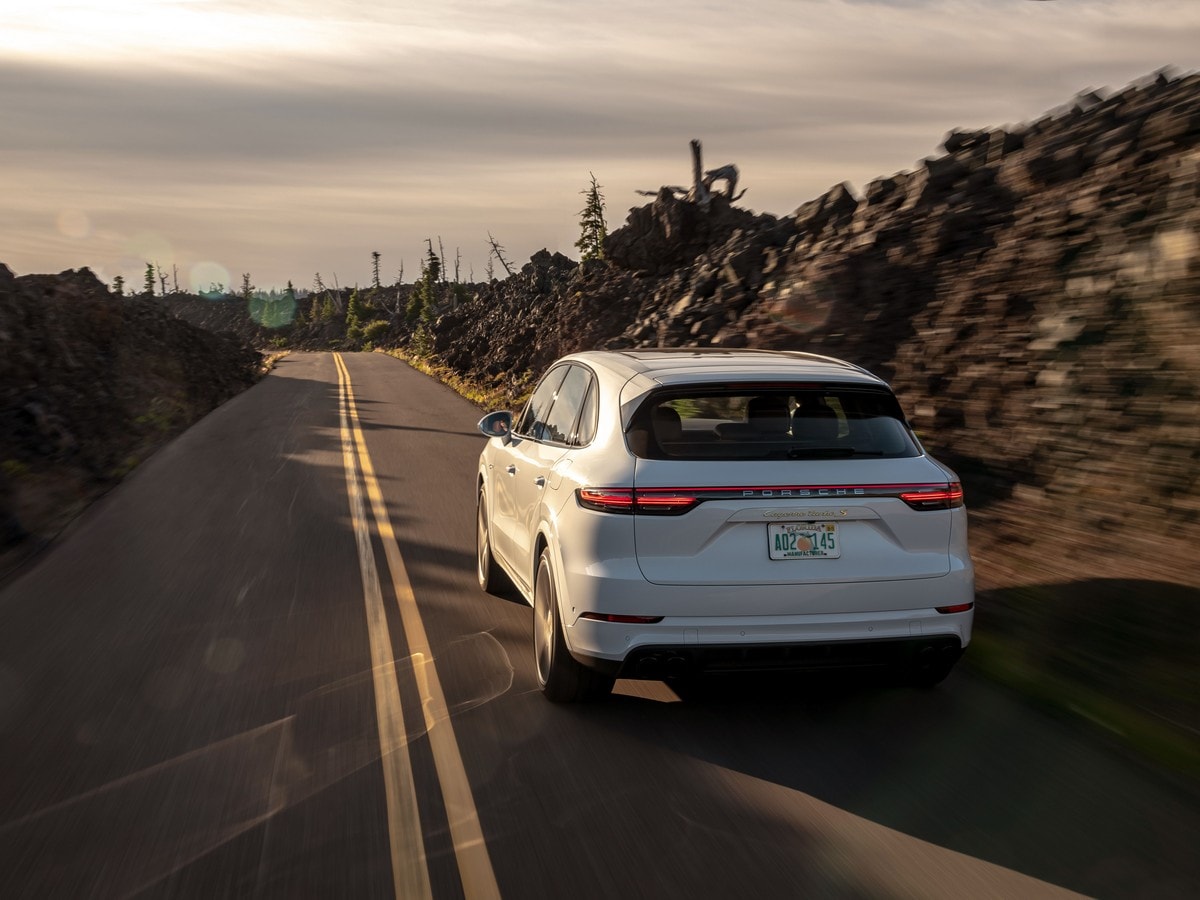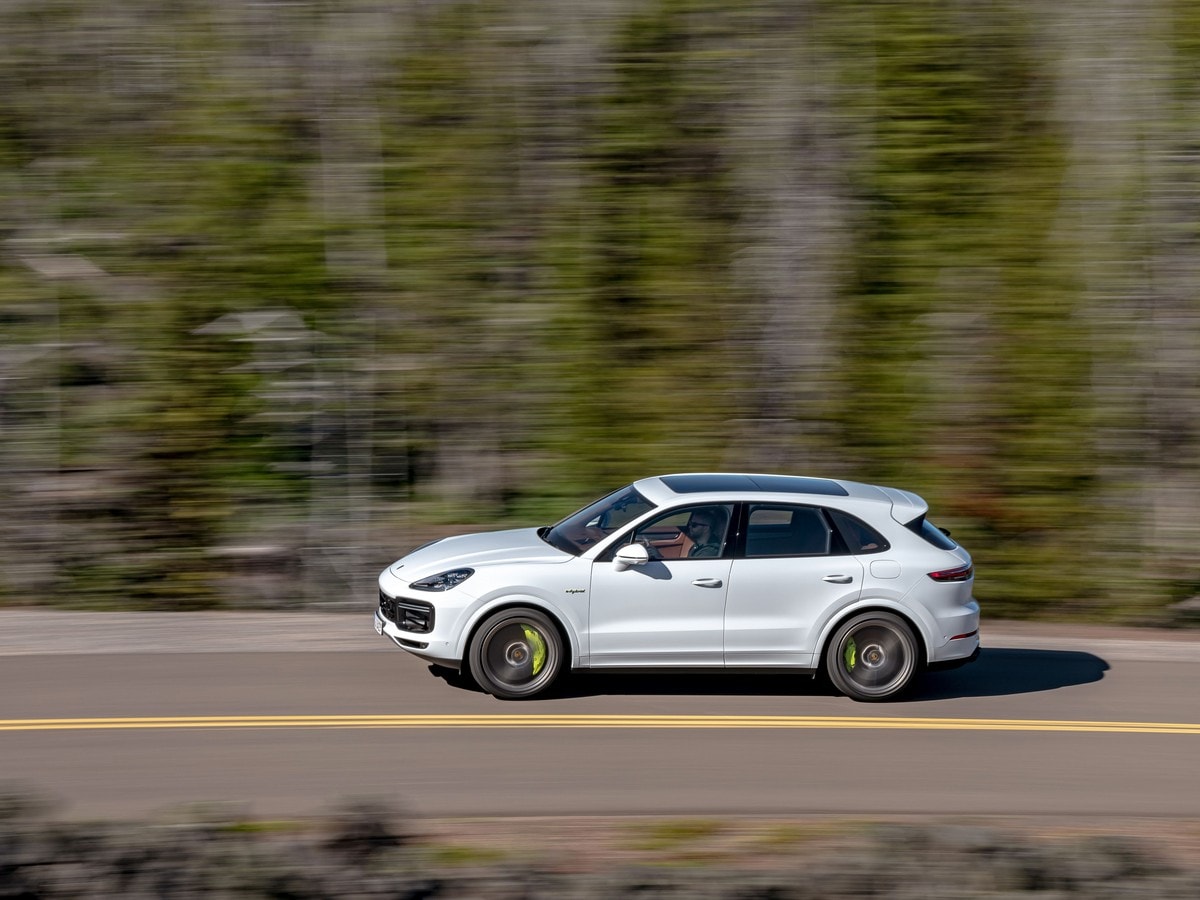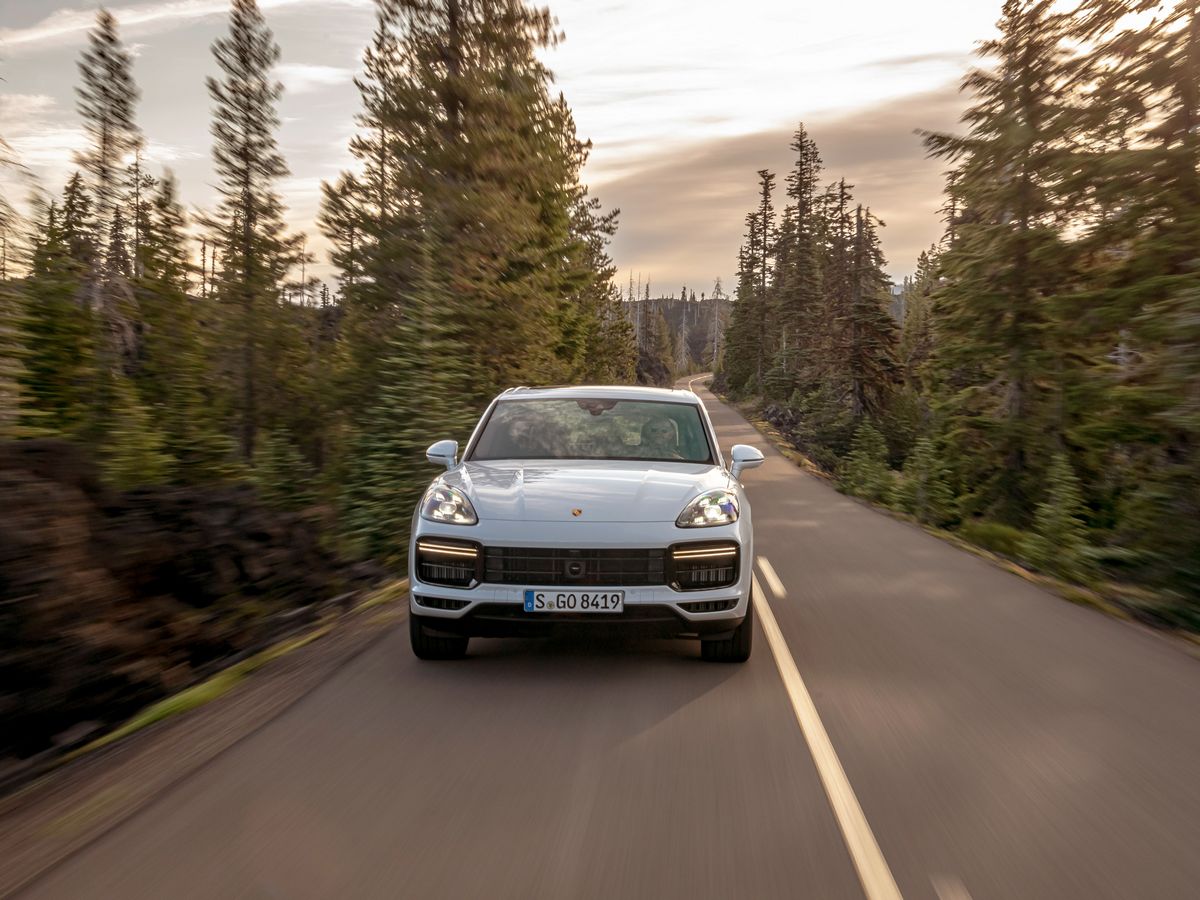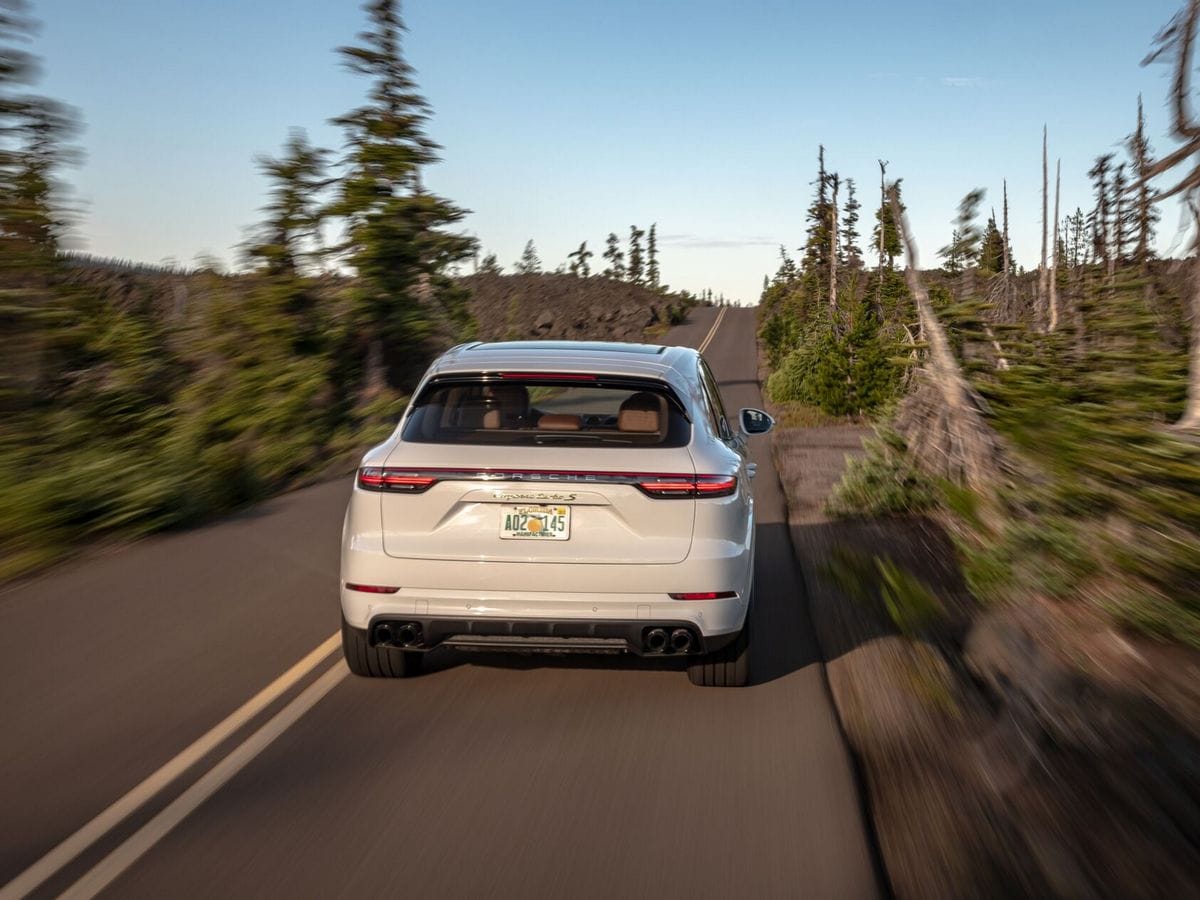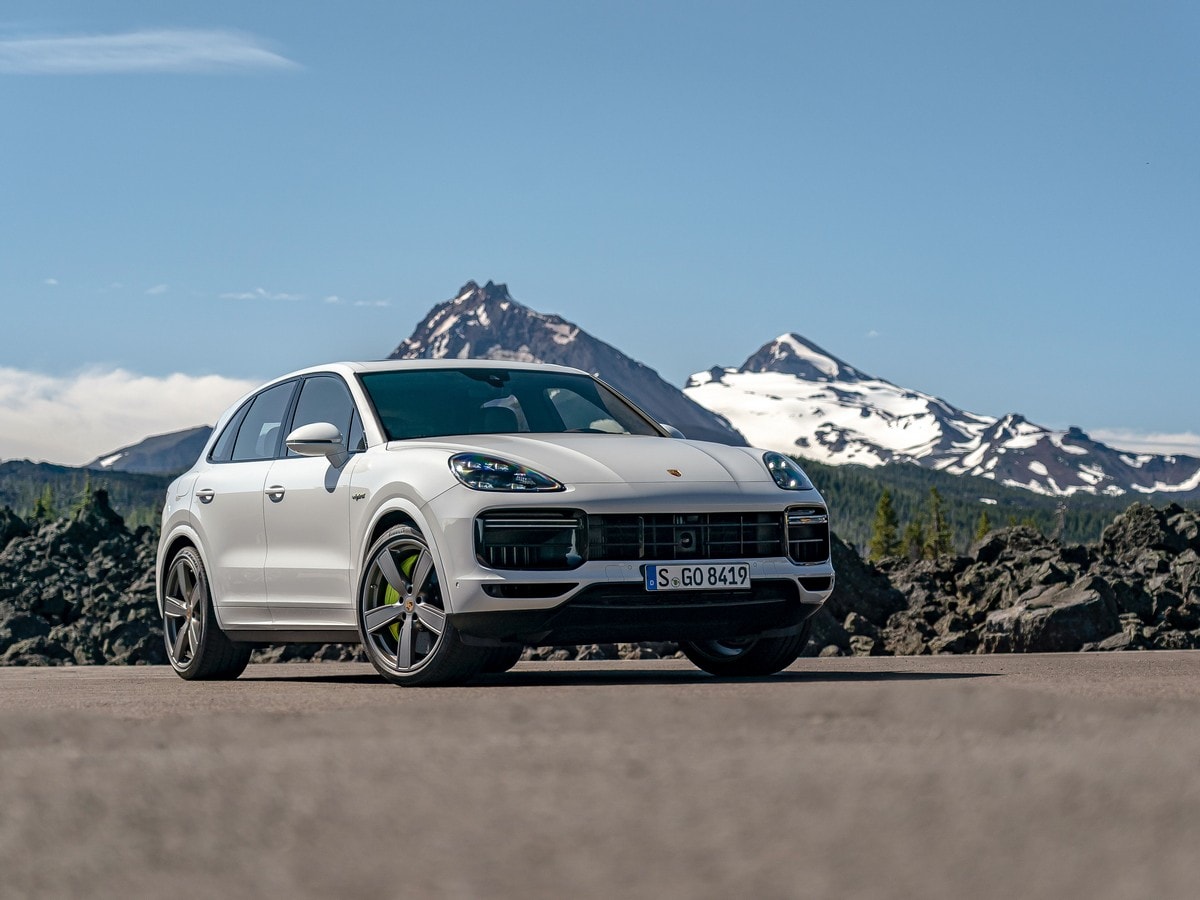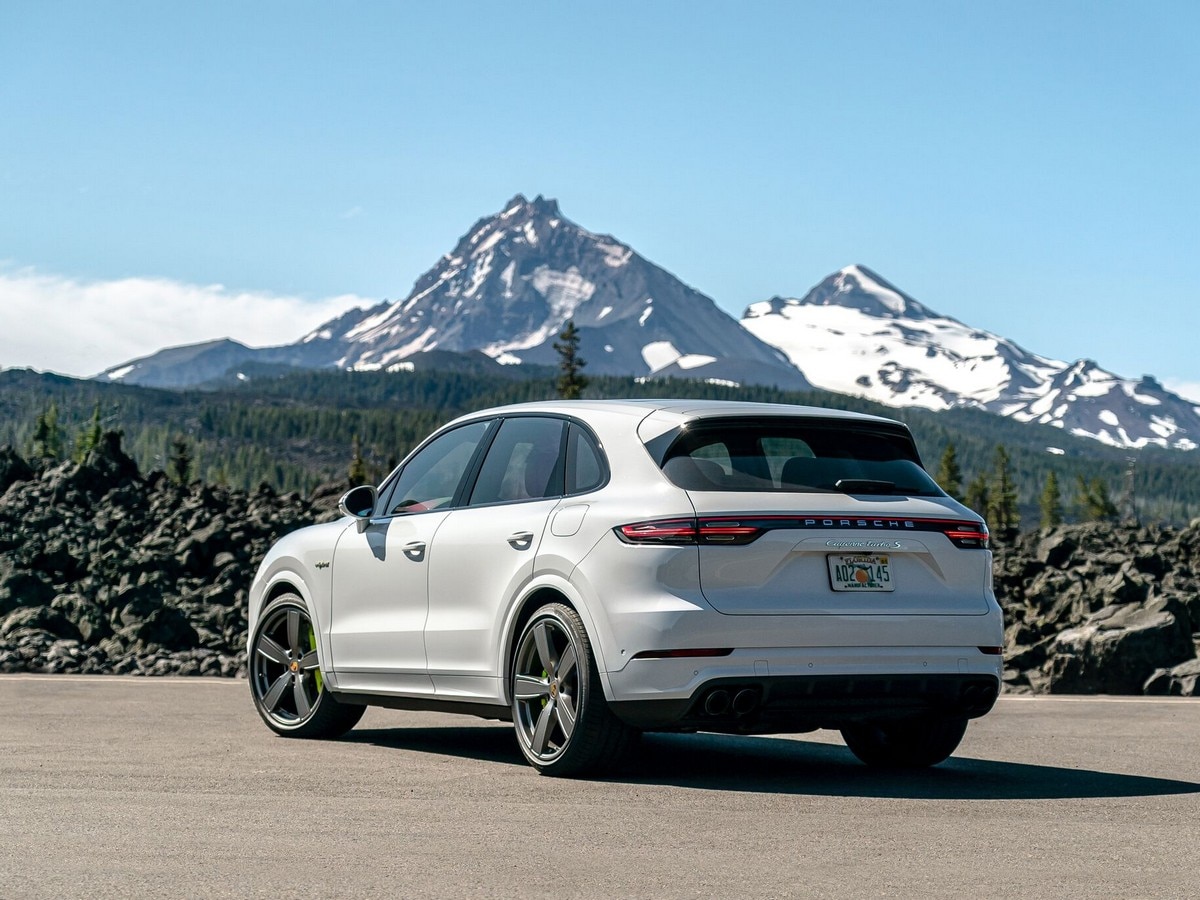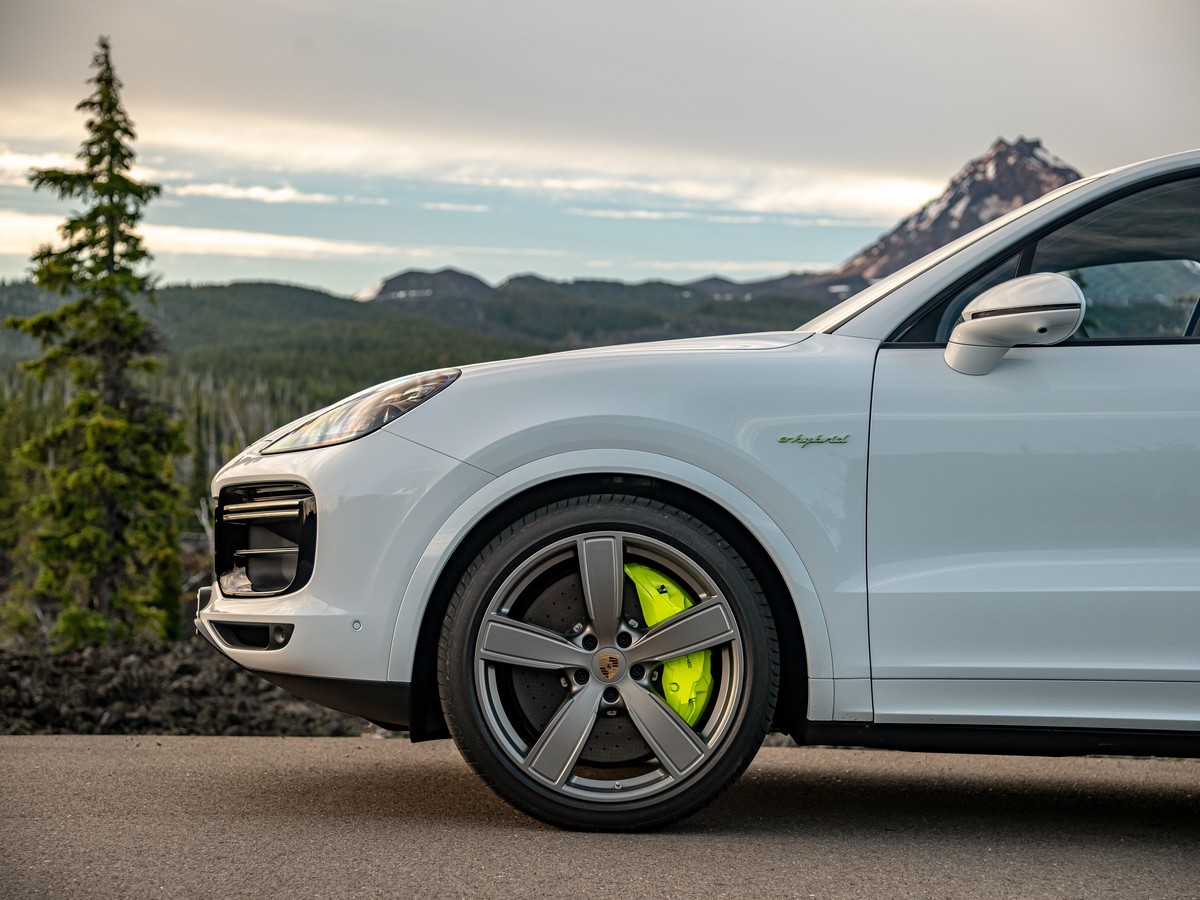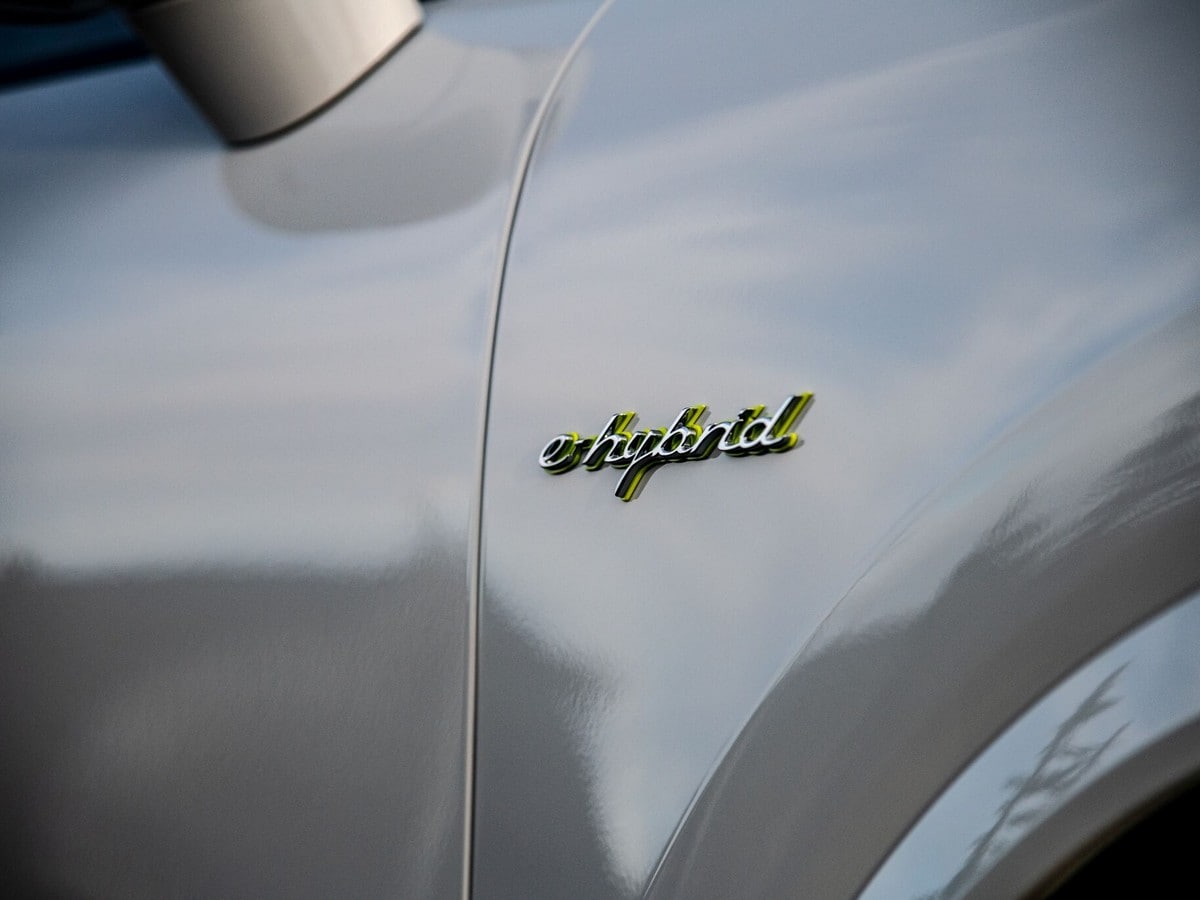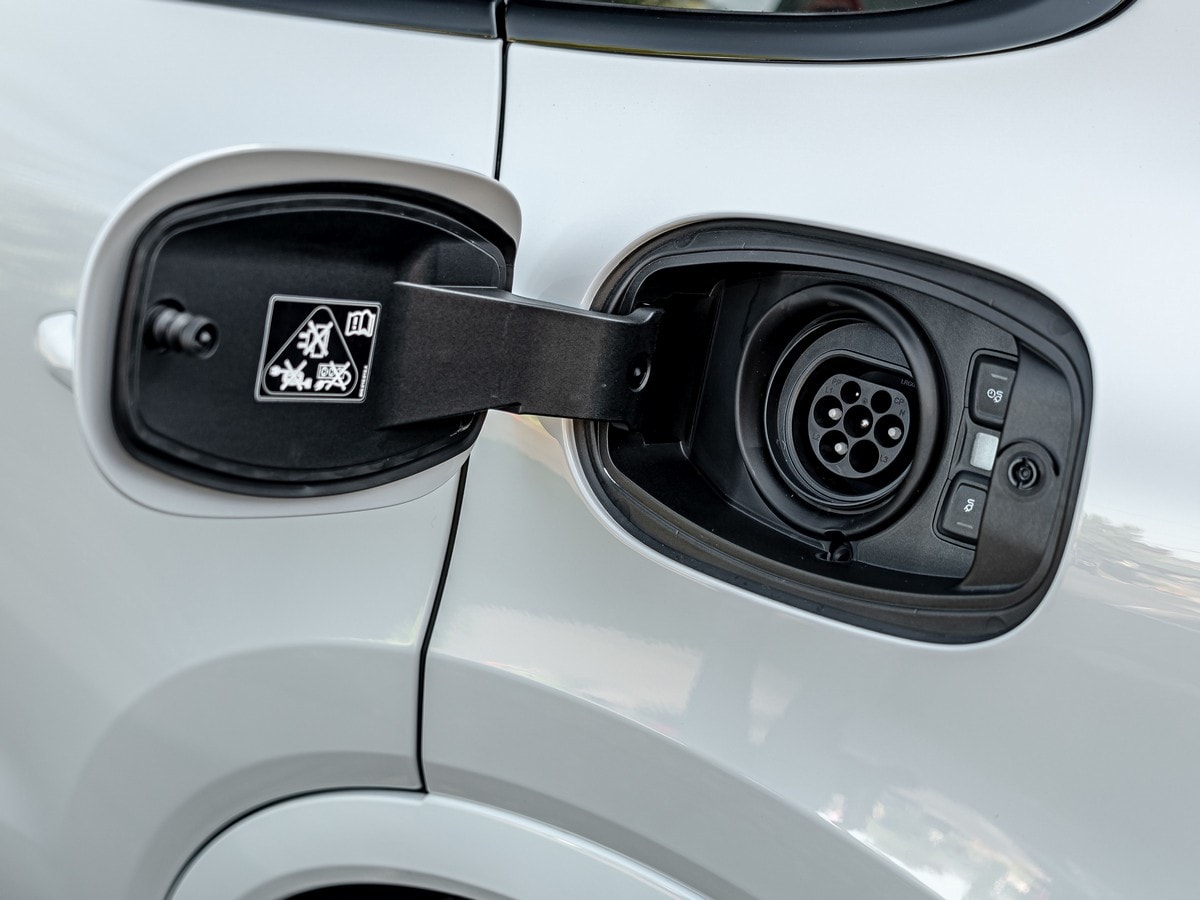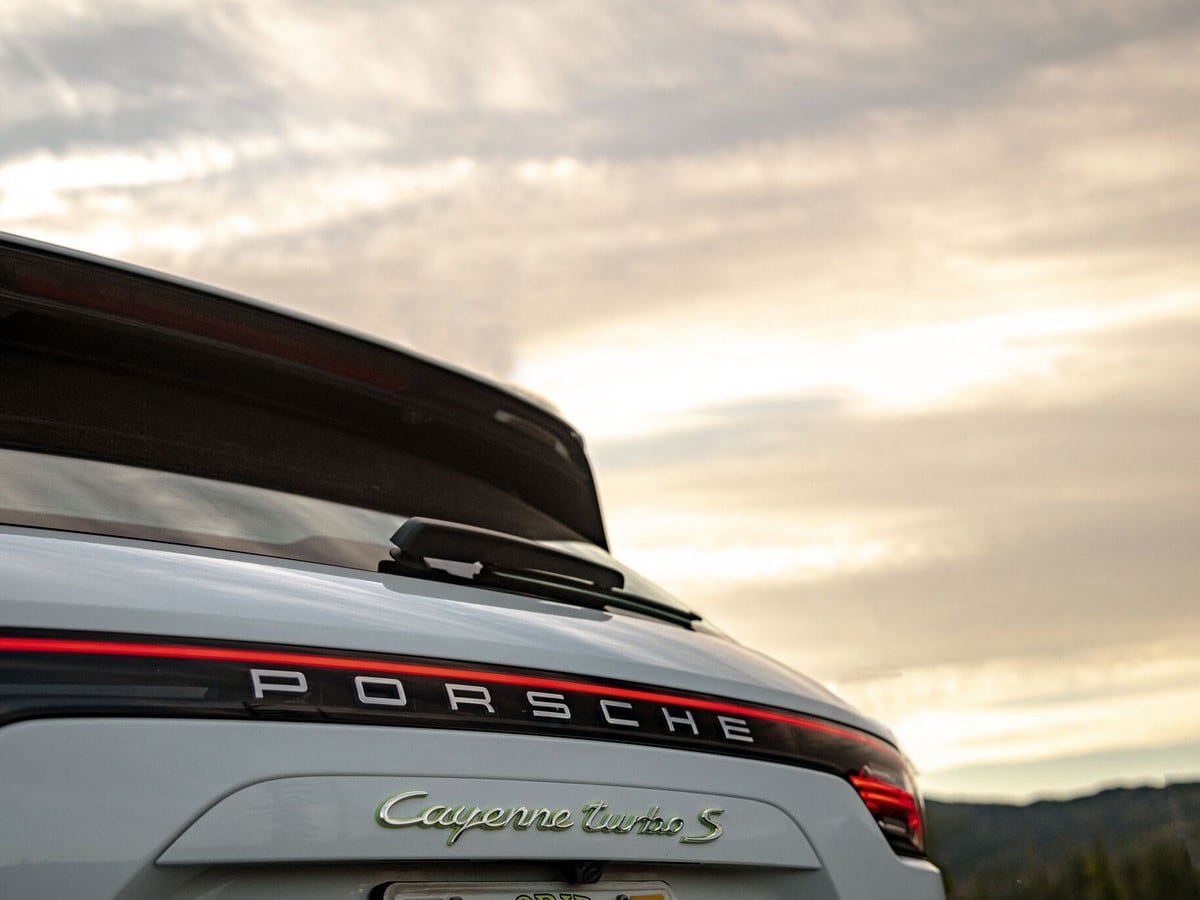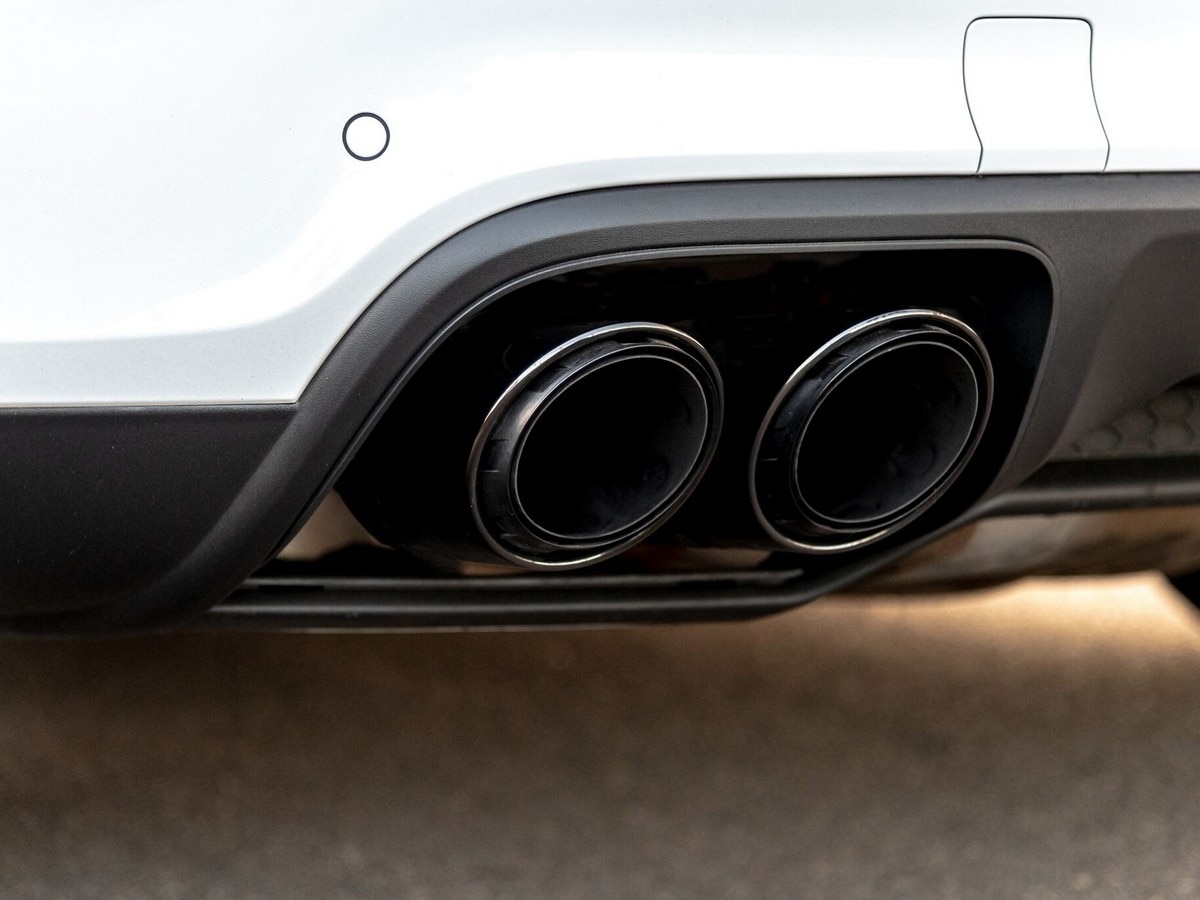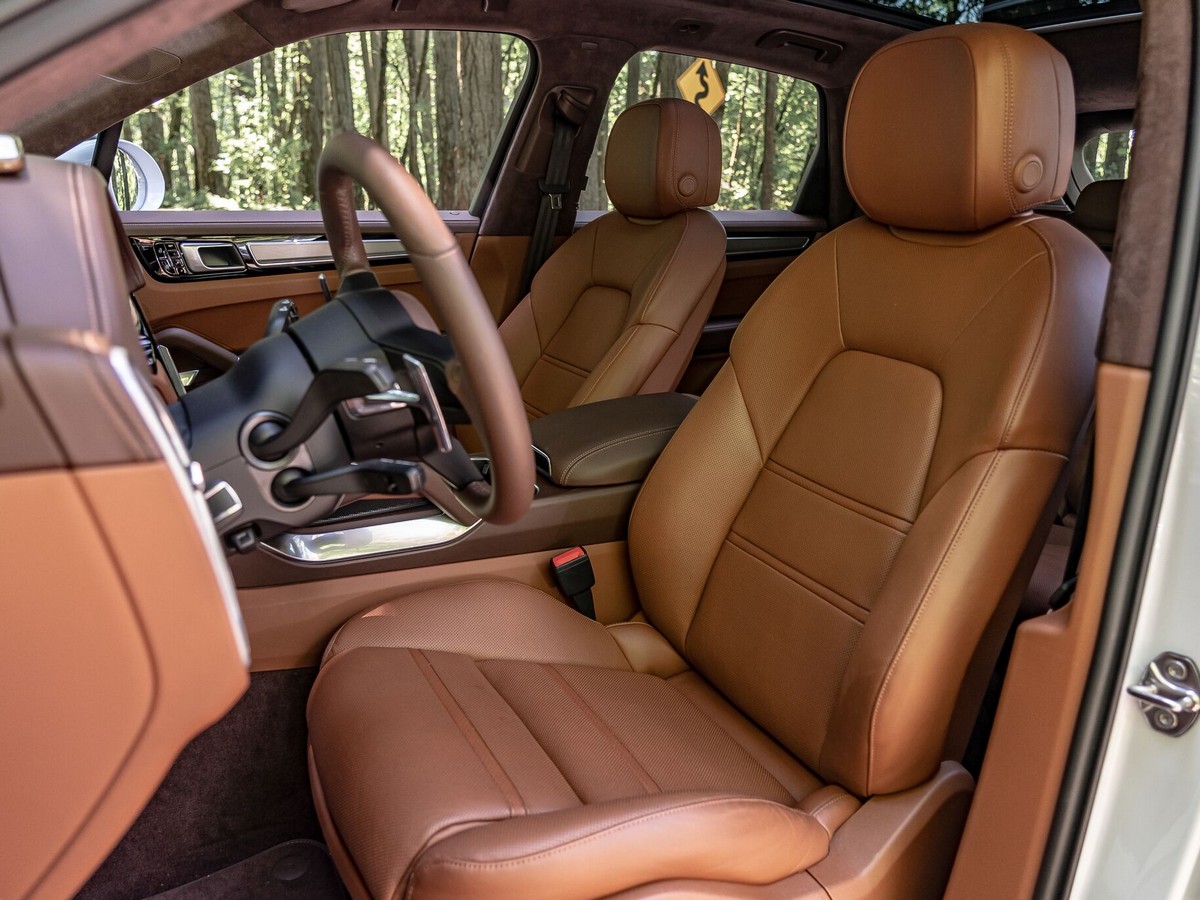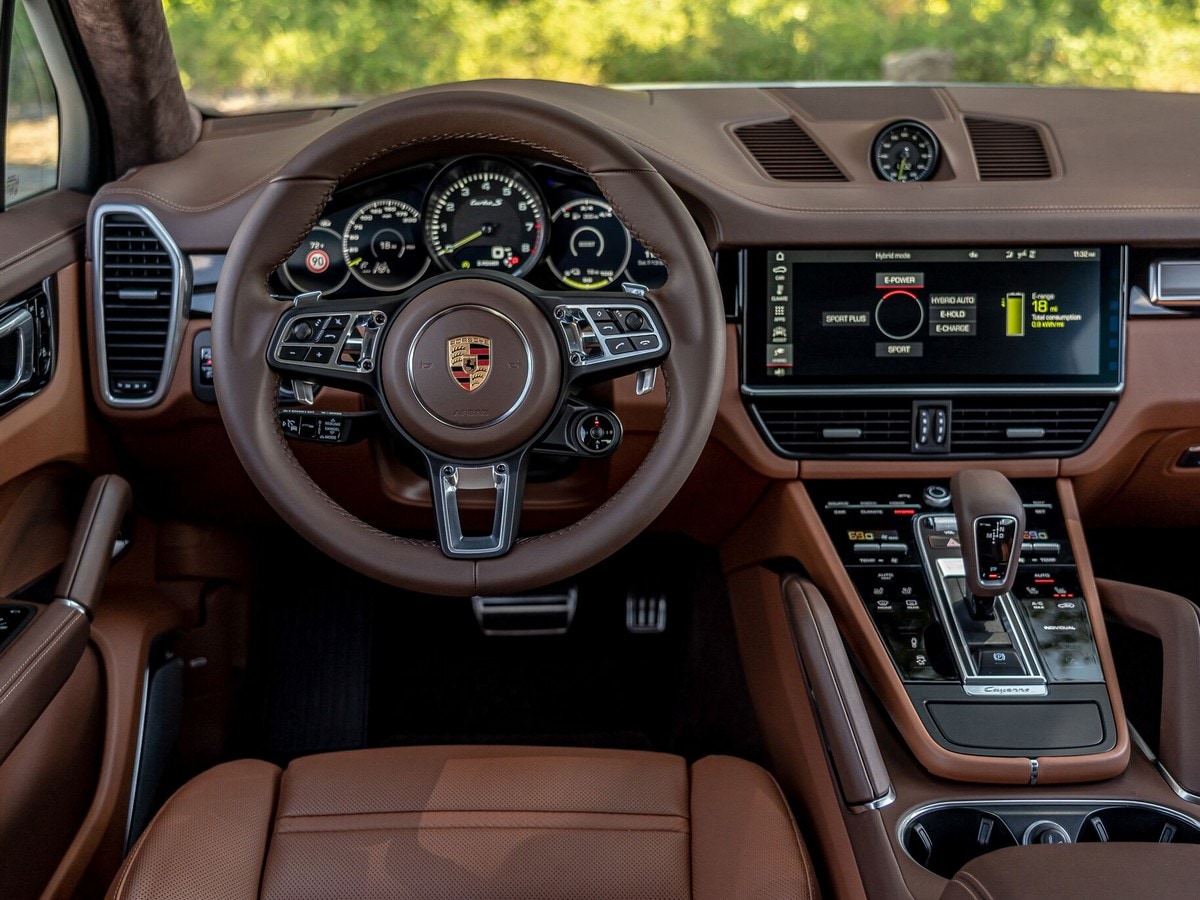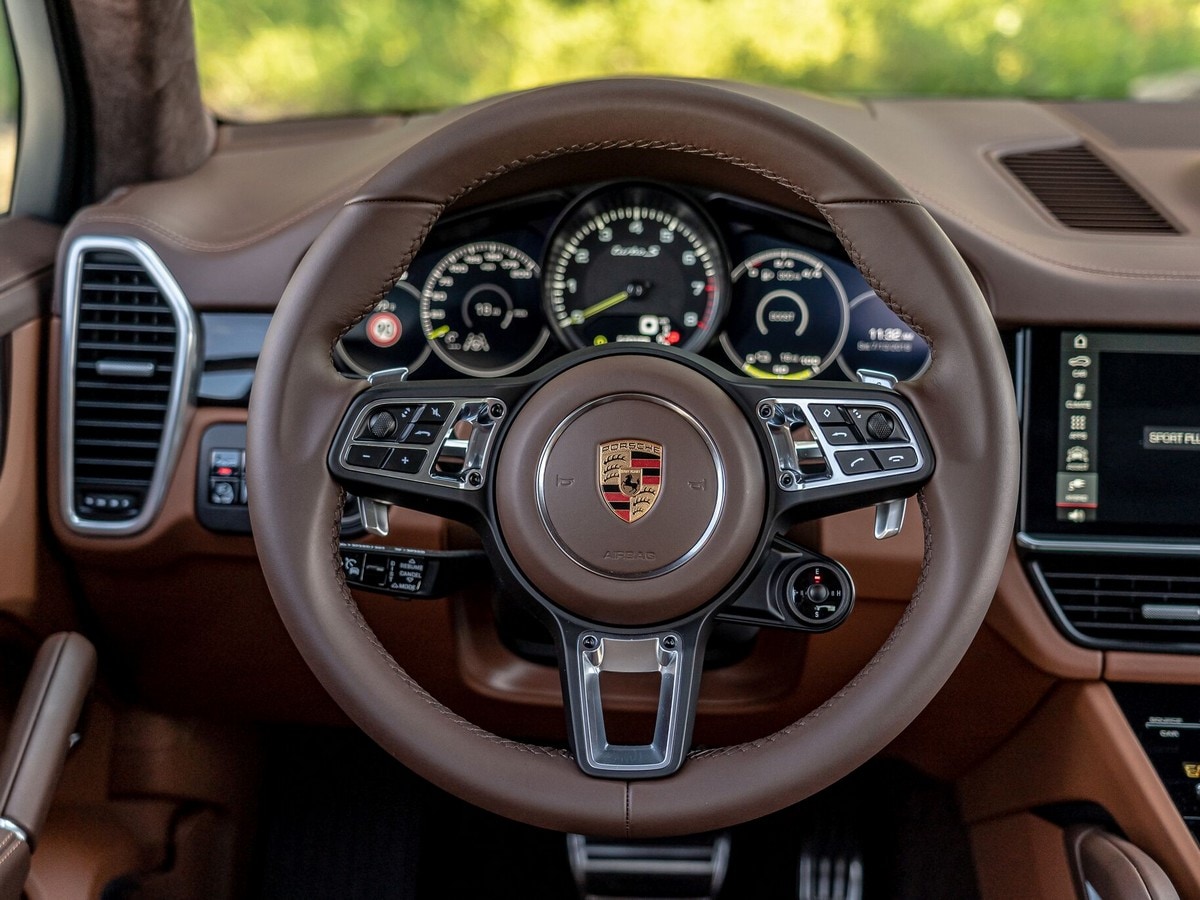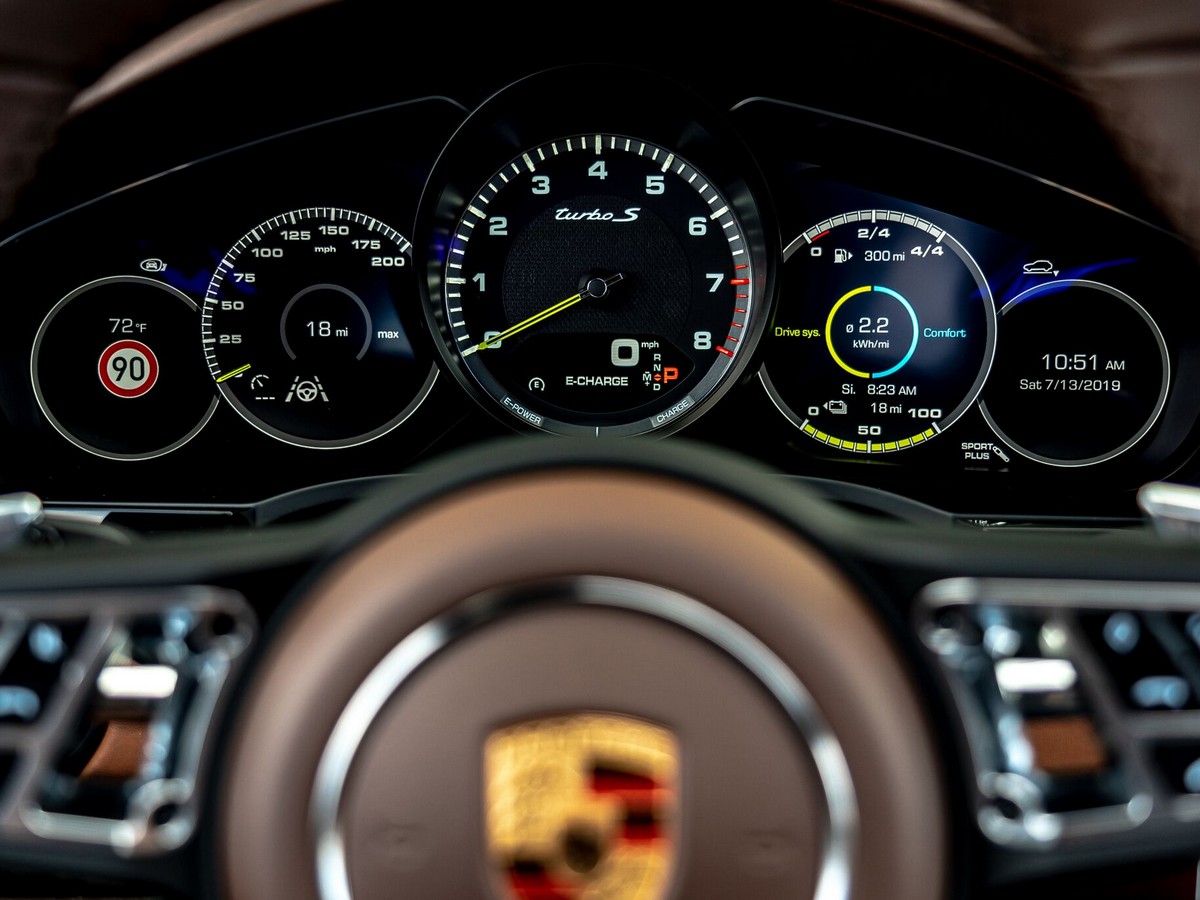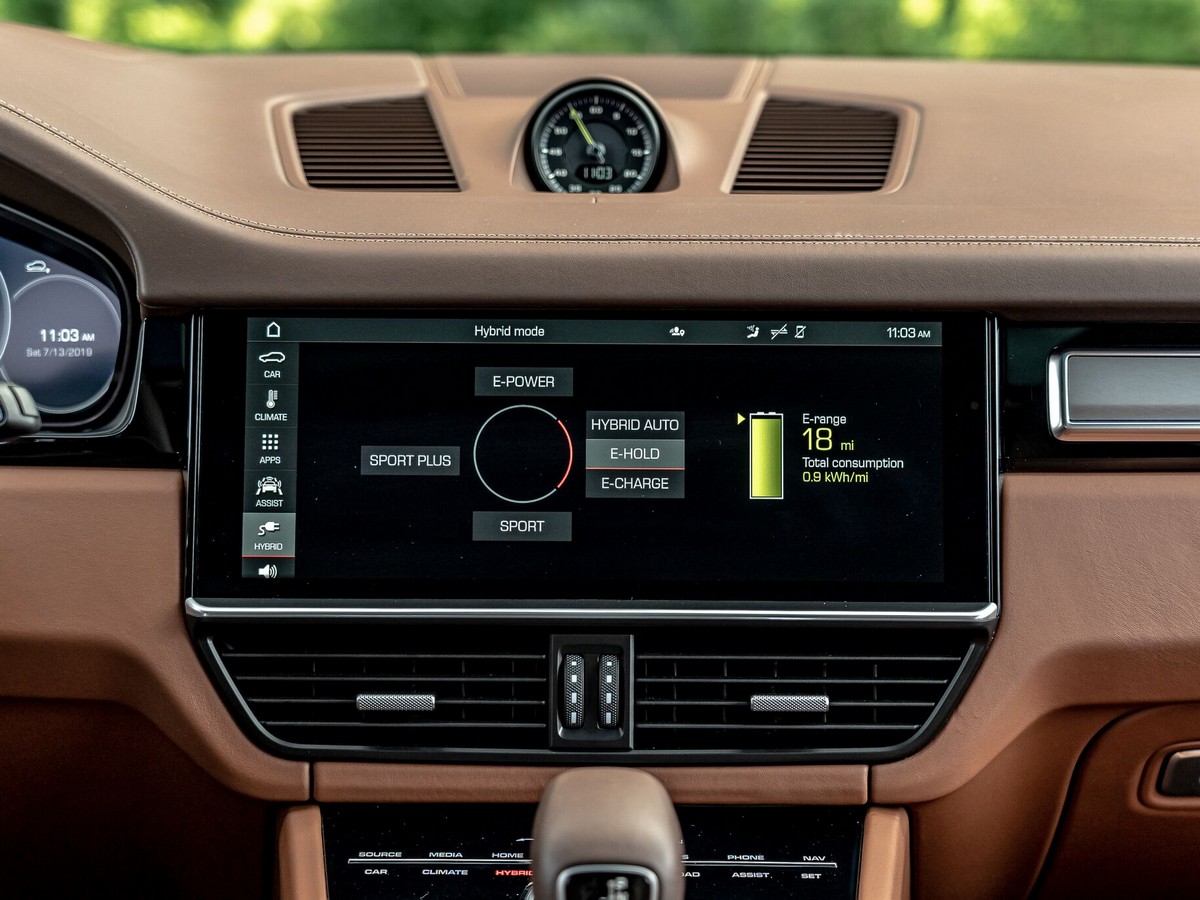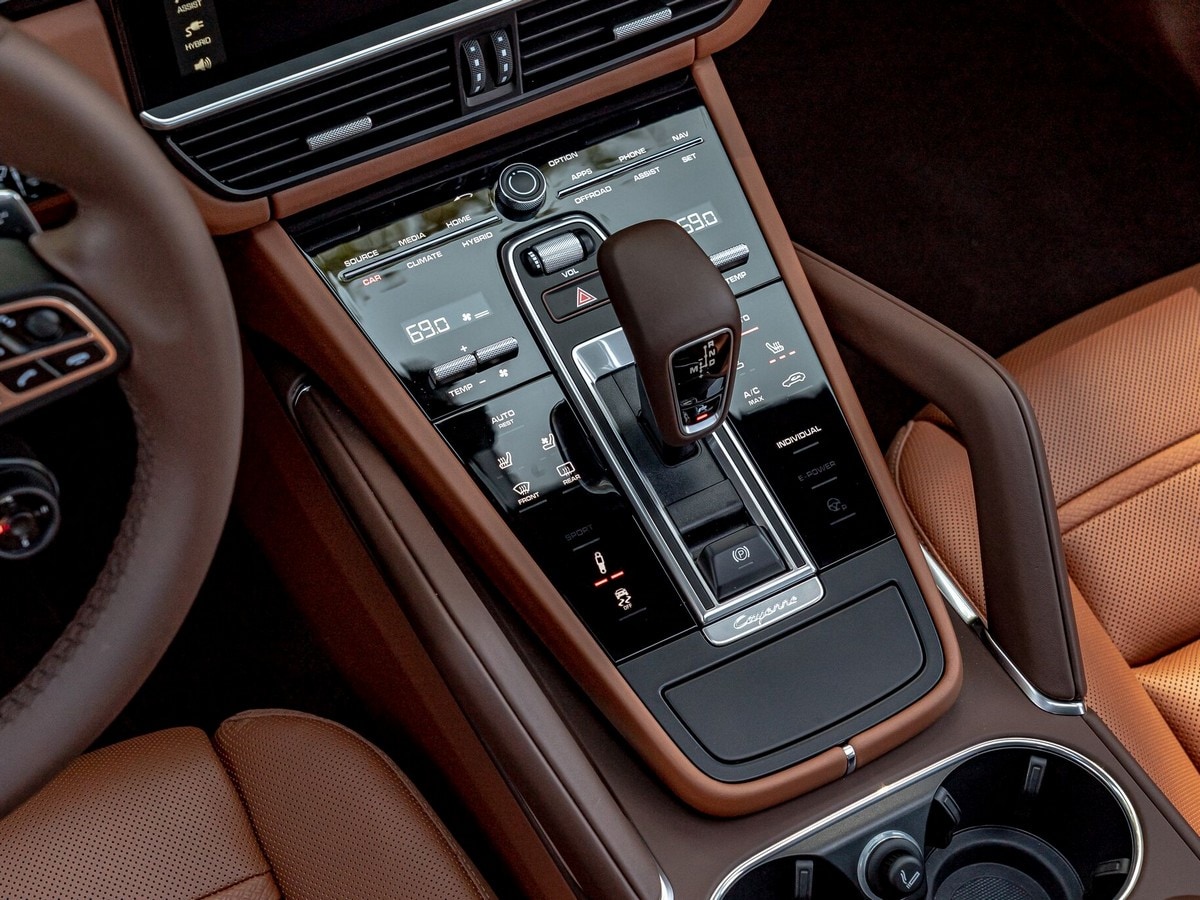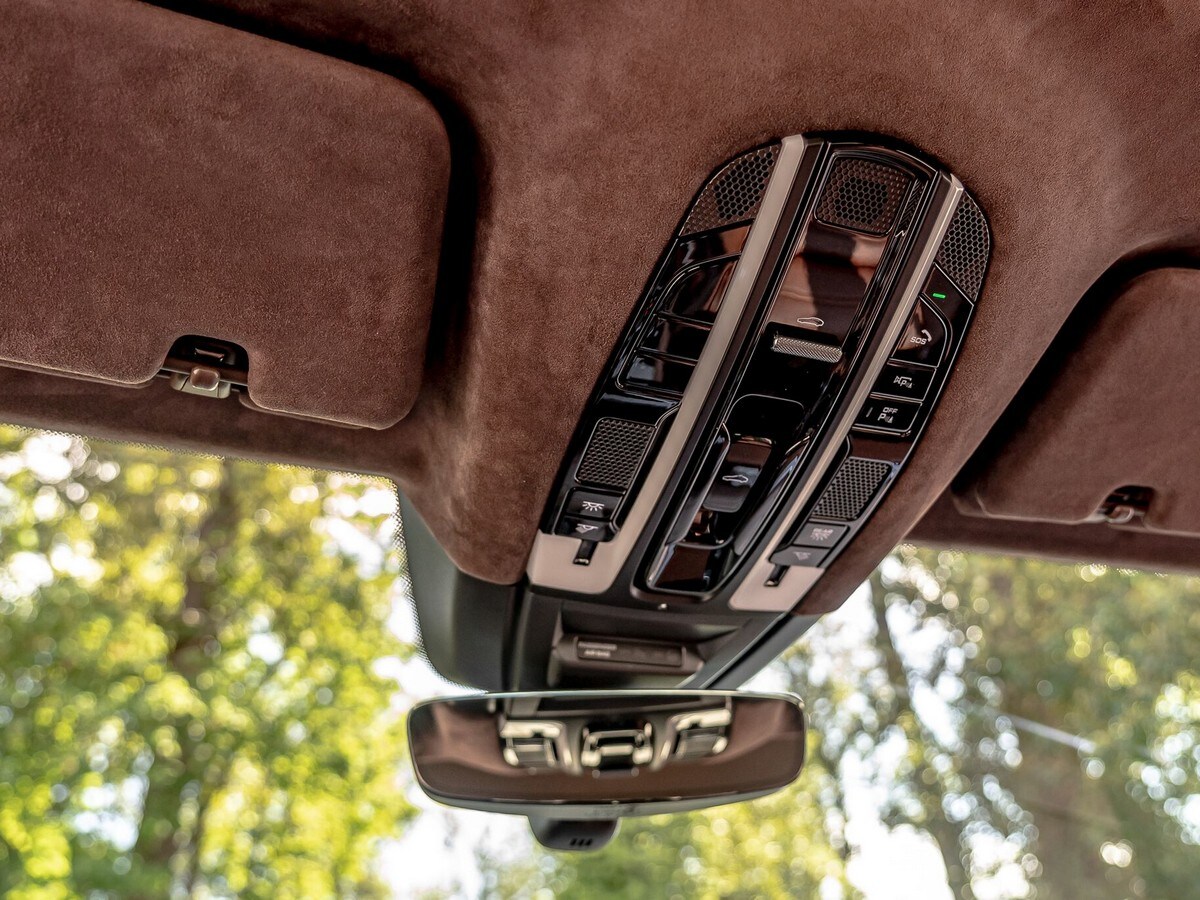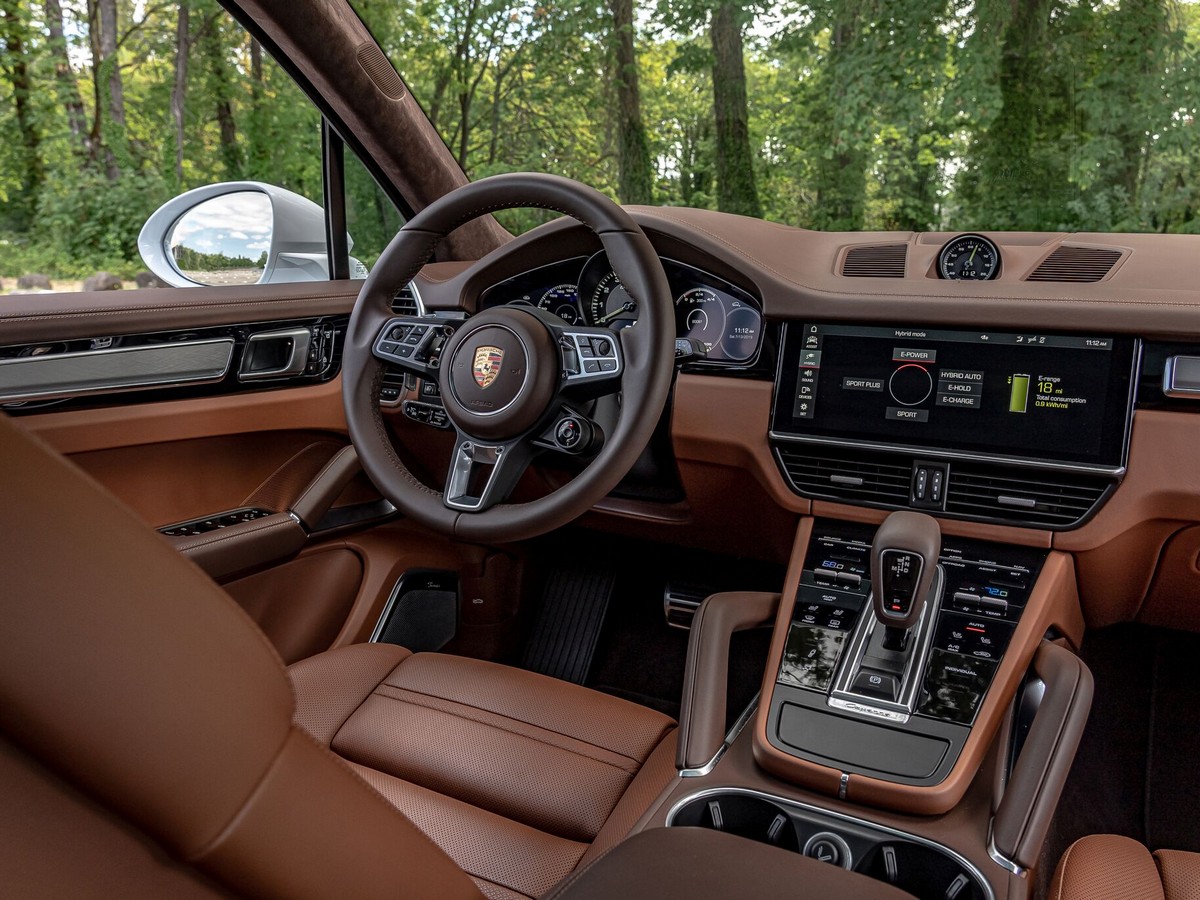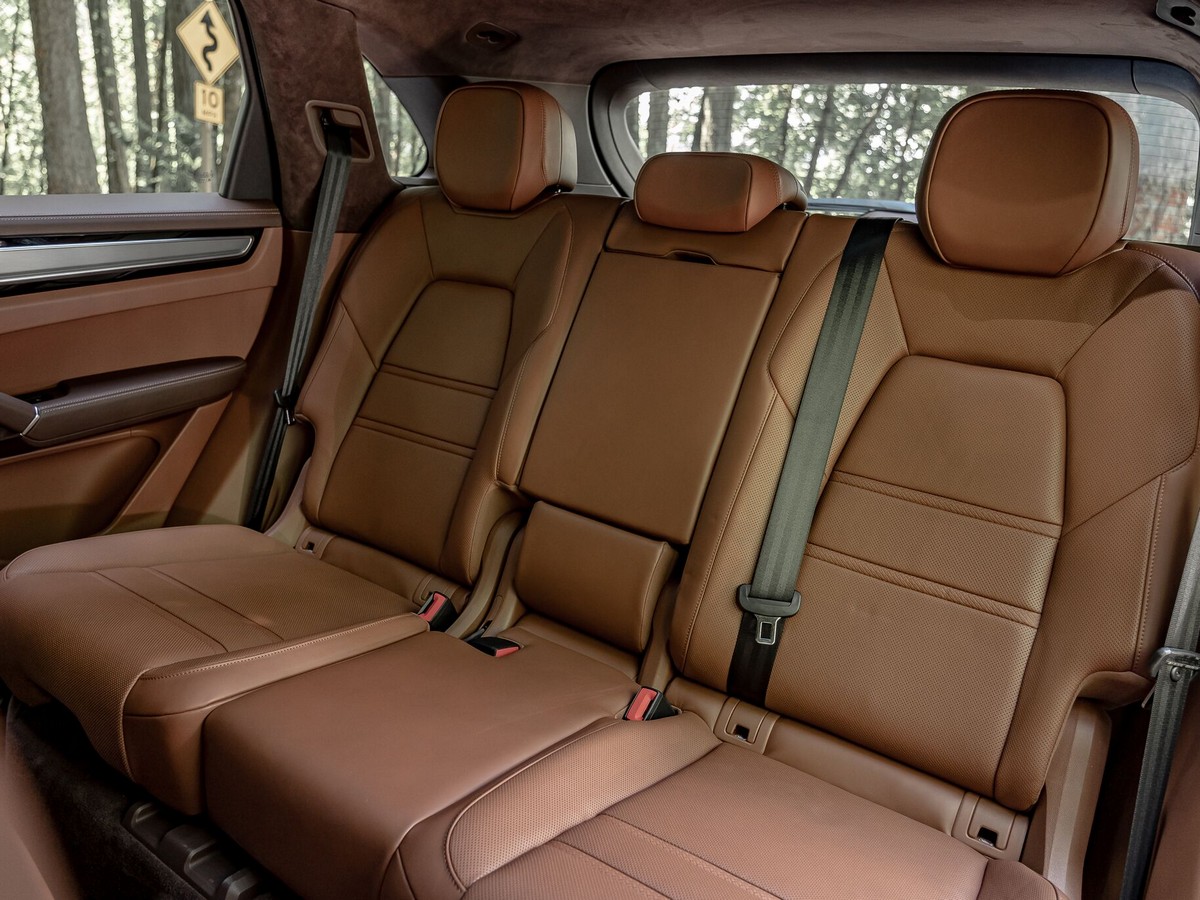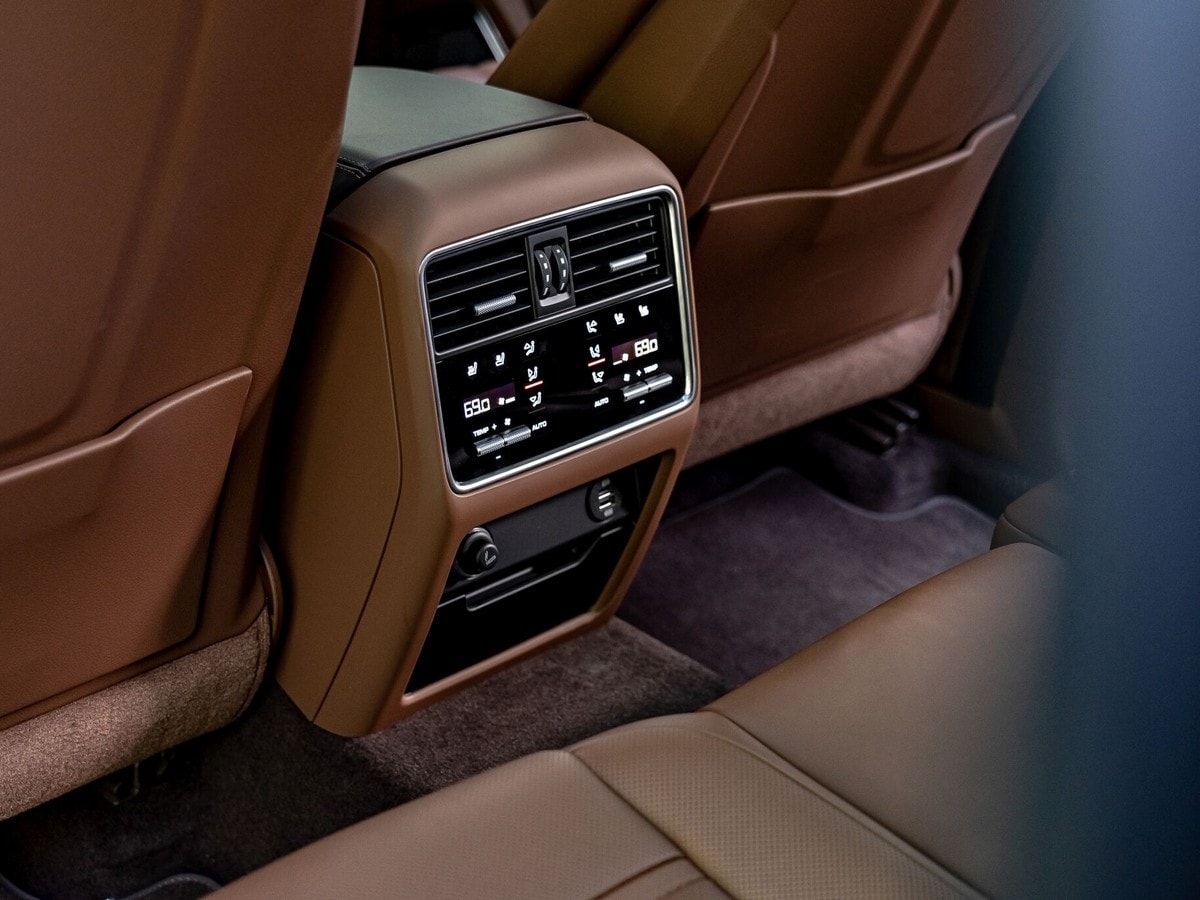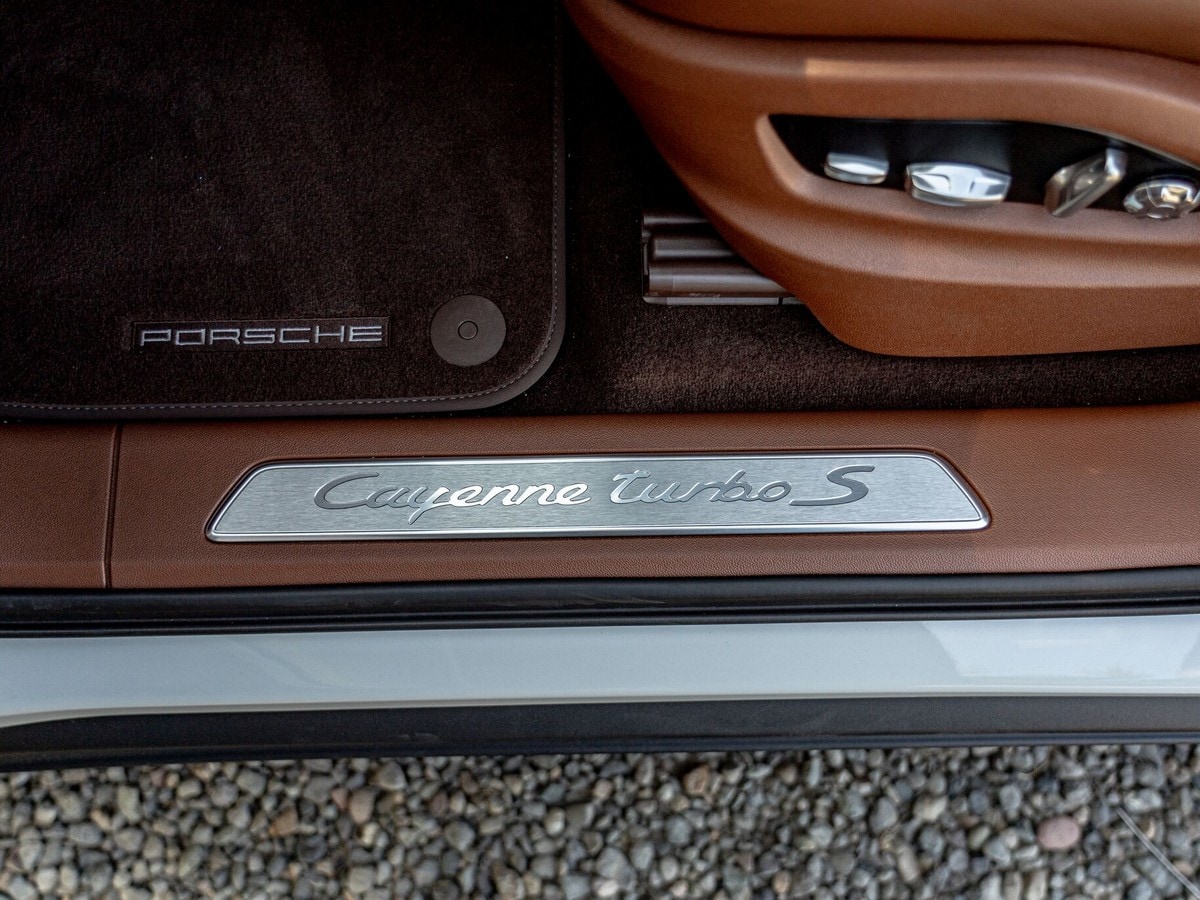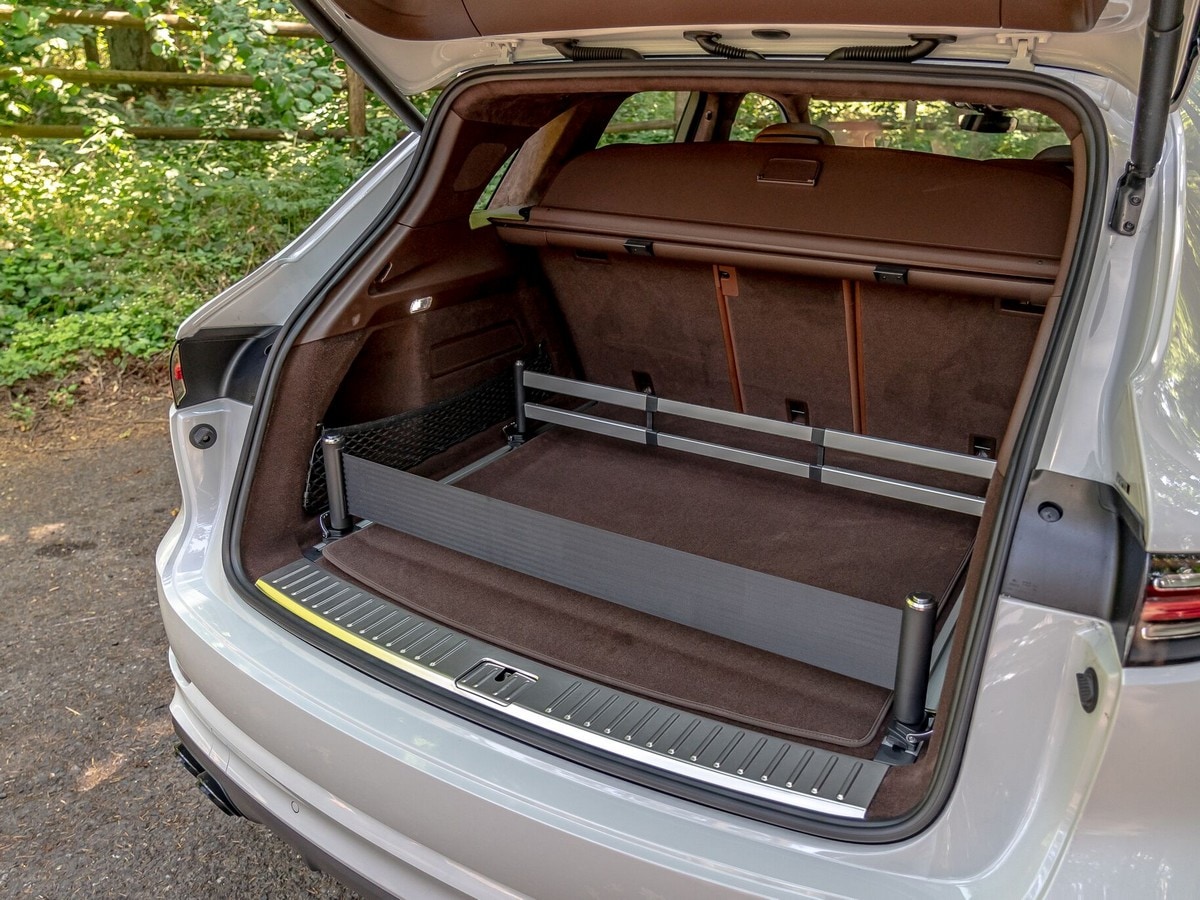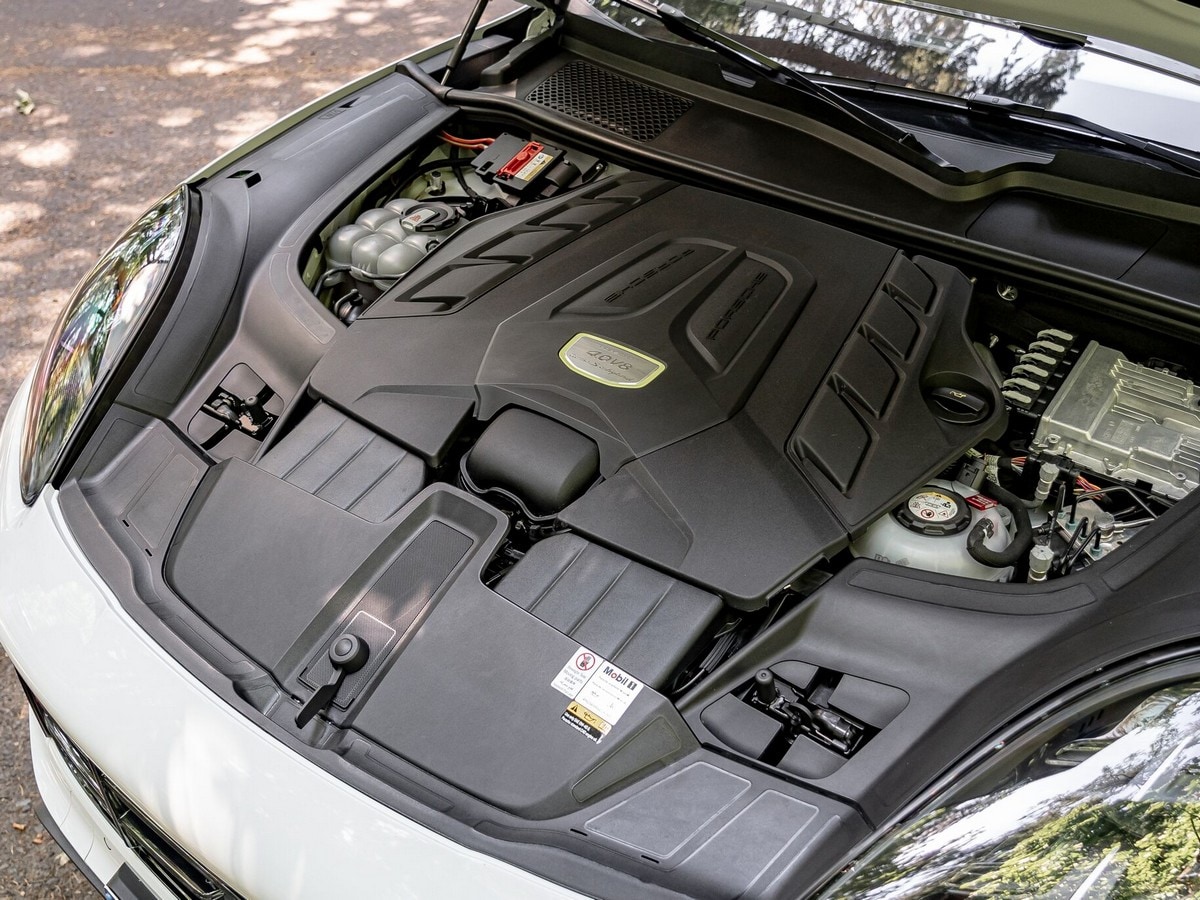- Most powerful Porsche Cayenne ever is a plug-in hybrid
- Hybrid V8 powertrain produces 670 peak horsepower
- Hits 60 mph in 3.6 seconds
- Top speed: 183 mph
- On sale in February, priced at $161,900
- A coupe version also will be available, priced at $164,400
Hybrid sport-utility vehicles aren’t supposed to emit little backfires under deceleration. Nor should they make fluffy exhaust pops during snappy full-throttle upshifts. But that’s exactly what the new 2020 Porsche Cayenne Turbo S E-Hybrid does when it’s being driven hard. Indeed, we found this rumbly 3rd-generation Porsche SUV, a plug-in hybrid (PHEV) model that tips the scales at over 5,000 pounds, to be an absolute kick to drive. No surprise, this V8-powered PHEV is the fastest Cayenne in Porsche’s stable of SUVs.
Just how fast is it? Well, with 670 peak horsepower, the all-wheel drive Porsche Cayenne Turbo S E-Hybrid launches to 60 mph in 3.6 seconds and blasts to a top speed of 183 mph. Prius owners: This Porsche is not your idea of an mpg-focused hybrid.
How much does the Porsche Cayenne Turbo S E-Hybrid cost?
When it goes on sale in February of next year, the 2020 Porsche Cayenne Turbo S E-Hybrid will carry a Manufacturer’s Suggested Retail Price (MSRP) of $161,900. The destination fee is $1,250. A 4-door coupe version, dubbed the Cayenne Turbo S E-Hybrid Coupe and sporting a far racier roofline, starts at $164,400.
Note: For those wanting a Porsche Cayenne Hybrid right now, one’s already available. The 2019 V6-powered Cayenne E-Hybrid starts at $79,900, plus the same destination fee of $1,250. The V6 Cayenne Hybrid, a PHEV with 455 total horsepower, is no slouch. It hits 60 mph in 4.7 seconds and has a top speed of 157 mph.
What’s under the hood of the 2020 Porsche Cayenne Turbo S E-Hybrid?
The Cayenne Turbo S E-Hybrid combines a 541-horspower twin-turbo 4.0-liter V8 engine with a 100-kW electric motor. The gas engine, of note, has a pair of twin-scroll turbochargers mounted inside the vee of its aluminum block. A 100-kW electric motor, mounted between the engine and 8-speed Tiptronic automatic transmission, connects to the drivetrain via a clutch that allows for gasoline or electric propulsion, or a combination thereof.
Porsche, incidentally, says the Cayenne Turbo Hybrid uses a boost strategy borrowed from the 918 supercar. In layman’s terms, this means the 134-horsepower electric motor supplements the 4.0-liter V8 by offering an immediate boost of power during urgent acceleration while also providing efficient electric-only propulsion whenever necessary.
Where’s the battery in the new Porsche Cayenne Hybrid?
The Cayenne Hybrid’s liquid-cooled lithium-ion battery, a 14.1-kWh pack supplied by Samsung, is mounted beneath the rear cargo area. Because the battery is there, the floor of the Cayenne Hybrid’s cargo hold has been raised by about an inch (28 millimeters). Porsche says the new battery is about the same physical size as that of the previous Cayenne Hybrid, but with 30 percent better energy density.
With the standard 7.2-kW onboard charger, the Cayenne Hybrid’s battery can be fully charged in six hours via a 220-volt system with a 10-amp fuse. Using the Porsche Connect app, Cayenne Hybrid owners can use their smartphones check charge status of the battery, the electric range, the overall range, and remaining charge time.
The app also can be used to schedule the charging process remotely. The air temperature of the Cayenne’s cabin also can be heated or cooled prior to driving. If the Cayenne Hybrid is plugged in during this process, the power to do this comes from the electrical grid. If Porsche’s new PHEV SUV is not plugged in, the preconditioning of the air is powered by the onboard 14.1-kWh lithium-ion battery pack.
Five drive modes
The 2020 Porsche Cayenne Turbo S E-Hybrid is equipped with the Sport Chrono Package, which has a driving mode switch integrated into the steering wheel. Five modes are available.
- E-Power: As soon as you fire up the Cayenne E-Hybrid, it by default is in this all-electric mode, meaning it will operate solely electrically until the battery drops to a certain level. Moreover, the accelerator pedal has a variable pressure point that is automatically adjusted related to battery charge. If you keep the pedal above that point of added resistance, the Cayenne stays in E-Power mode; if you push through that point with your right foot, the gasoline engine automatically starts in smooth, almost undetectable, fashion.
- Hybrid Auto: In this mode, vehicle propulsion comes from both the gasoline engine and the electric motor, as determined by the Cayenne Hybrid powertrain’s brain. Hybrid Auto is is good for everyday use.
- E-Hold: When the Cayenne Hybrid driver wants to keep the current state of charge in the battery pack (for possible all-electric vehicle driving later), this mode should be selected.
- E-Charge: The gasoline engine is used to both propel the Cayenne Hybrid and charge its battery.
- Sport and Sport Plus: In Sport mode, battery charge is maintained at a certain level to ensure there’s an electric boost always available. In Sport Plus, the engine recharges the battery as quickly as possible for maximum performance potential. Interestingly, the battery recharges more quickly in Sport Plus than it does in E-charge.
Porsche Cayenne Turbo S E-Hybrid Air Suspension
Air suspension, with five ride heights and a wide variety of spring rates, is standard on the new V8-powered Cayenne Hybrid. To ensure the best ride comfort, the suspension is most often in a soft mode that automatically switches to higher spring rates when strong pitch and roll movements are sensed.
Also playing a role here is Porsche Active Suspension Management. PASM, which is standard, automatically adjusts the suspension damping at each wheel, depending on road conditions and driving style. Normal, Sport and Sport Plus modes are available.
A word about Cayenne Hybrid ride heights: They’re selected by the driver or automatically set by the vehicle, dependent on the driving situation and driving mode. Ground clearance varies from 6.3 inches in its lowest setting to 9.6 at its highest. For reduced aerodynamic drag and better high-speed stability, Low mode becomes active at or above 131 mph, aided by an active spoiler on the trailing edge of the V8 Hybrid’s roof. Incidentally, there’s an even lower level that facilitates the loading of cargo into the parked Cayenne Hybrid; it’s accessible via a switch in the cargo area.
Porsche Dynamic Chassis Control
The PDCC suspension system, which counters body lean in corners, is standard on the 2020 Porsche Cayenne Turbo S E-Hybrid. It’s a nifty system. By adjusting the torsional rigidity of the front and rear anti-roll bars, Porsche says it’s able to completely suppress the body roll of a Cayenne Hybrid (with two people aboard) at cornering forces of up to 0.8g.
The secret lies in the front and rear anti-roll bars that are divided into two halves and joined by 48-volt pivot motors that rotate the respective halves in opposite directions to counter body roll. It works like magic in milliseconds, giving the V8-powered Cayenne Hybrid unreal cornering composure.
PDCC also has benefits off-road. In slow-going situations with big dips and boulders, PDCC effectively disengages the front and rear anti-roll bars for greater axle articulation and better tire contact with the dirt. While it might seem crazy to go off-roading in your $160,000 Cayenne Hybrid, it’s nice to know that Porsche had designed it to do just that. Off-road driving modes include Easy Terrain, Muddy Ground, Sand and Rocky Terrain. In these modes, the powertrain, chassis and differential locks are all preselected for the respective settings.
One other note: On smooth and straight highways, the active anti-roll bars of the Cayenne Turbo S E-Hybrid also are effectively disconnected. This results in a smoother ride because the spring and wheel movements are damped independently of one another.
4-wheel steering? You bet!
Rear-axle steering is optional on all new Cayennes. The rear wheels can point 3 degrees in either direction, enhancing high-speed stability on the highway and decreasing the Cayenne’s turning radius from 40 feet to 37.7. At speeds up to 49 mph, the Cayenne’s rear axles steer in the opposite direction of the fronts, enhancing agility. Above that speed, the rears steer in the same direction as the fronts for added stability, particularly in lane changes.
Abundant technologies
As Porsche’s flagship SUV, the Cayenne Turbo S E-Hybrid is loaded with modern driver-assist technologies. Adaptive cruise control (with stop and go) uses onboard navigation data and cloud-based information to calculate optimum acceleration values for the next 1.8 miles. Corners, grades and speed limits are all taken into account by this system, which also uses radar and video sensors to detect current traffic. The automatic distance control function of the adaptive cruise is active between 19 and 130 mph.
Other contemporary technologies include predictive pedestrian protection (which can provide visual and acoustic warnings when a pedestrian or cyclist is in a danger zone) and lane-keep assist with traffic sign recognition (which functions from 41 mph all the way up to 155). Swiveling LED headlights (that point into turns) are available on the Cayenne V8 Turbo Hybrid, as are a customizable head-up display (HUD) and a thermal night vision camera that sees 984 feet ahead and can reportedly differentiate between an animal and a parked motorcycle with a warm engine.
What’s the EPA fuel economy of the 2020 Porsche Cayenne Turbo S E-Hybrid?
That’s the million-dollar question. Porsche hasn’t announced the EPA fuel economy of the 2020 Cayenne Turbo S E-Hybrid yet. We do, however, know this: The 2019 Porsche Cayenne E-Hybrid – the one on sale now and equipped with the single-turbo 3.0-liter V6 engine – is rated by the EPA at 47 MPGe in electric mode and 22 mpg in combined city and highway driving.
Also worth noting: With the battery nearly fully charged in a new 2019 Porsche V6 Cayenne Hybrid, we observed an indicated electric-only range of 26 miles. We expect a similar (or possibly higher) pure-electric range in the new Cayenne Turbo S E-Hybrid.
The Cayenne Hybrid Interior
The Cayenne Turbo S E-Hybrid is a comfortable 5-seat SUV with 18-way adjustable front sport seats. Massaging front seats are available, but they offer “only” 14-way adjustability. Overall room is good inside the Cayenne Hybrid, and the 2nd-row seat slides fore or aft 6.3 inches to accommodate folks of various sizes.
A redesigned Porsche Advanced Cockpit display has a handsome look. It’s based on that of the 918 Spyder, but with additional hybrid-specific appearing on the Cayenne Hybrid’s instrument cluster and wide infotainment touch screen.
We like how the tachometer continues to be in a central, prominent position. On its left is the Hybrid Assistant, a metering aid that lets the driver know when the internal combustion engine switches on. The rotary driving mode switch–which includes a Sport Response button that provides immediate access to the Cayenne Hybrid’s most aggressive settings for a period of 20 seconds–is located at about 4 o’clock on the thick-rimmed leather wrapped steering wheel.
Class of 2020: The New and Redesigned Cars, Trucks and SUVs
Driving the new Porsche Cayenne Turbo S E-Hybrid
Did we mention that the new 2020 Porsche Cayenne Turbo S E-Hybrid is phenomenally quick? Sorry, but this point needs to be underscored. Yes, the V8-powered Cayenne Hybrid is a refined everyday driver that exudes high quality, but when you plant your right foot it becomes a different machine that accelerates with all the force of an exotic supercar while emitting the occasional backfire under deceleration. This Porsche PHEV seemingly defies physics, not just in its acceleration but also in how a high and heavy vehicle carves corners with such incredible grip and composure. It might also have something to do with the meaty Pirelli P Zero tires, size 285/40ZR-21 in front, 315/35ZR-21 rear.
Although Porsche hasn’t announced the Turbo S E-Hybrid’s EPA fuel economy ratings, we can tell from our initial drive that this Bratislava-built PHEV is not about extracting every last mile out of every last drop of fuel. Rather, this Porsche PHEV SUV relishes its role of turning gasoline and electricity into exhilarating speed and wide grins.
That stated, every time you start the Cayenne Turbo S E-Hybrid and begin driving, it’s in the E-Power pure-electric mode until the battery drops to a certain level and the twin-turbo V8 comes to life. “If you have any onboard electricity, you might as well use it” is how one Porsche representative explained his company’s thinking.
On the road, the Turbo S E-Hybrid drives much like the standard Turbo S Cayenne, a testimony to the smoothness of its refined hybrid drivetrain. You frequently need to look at the tachometer to see if the gasoline engine has started or stopped running. There is, however, one noticeable difference in feel: its brakes. The Hybrid’s brake pedal is a bit grabby on initial application, owing to the regenerative nature of its brakes.
The Cayenne Turbo S E-Hybrid’s brakes, by the way, feature massive carbon-ceramic rotors clamped by equally huge 10-piston front calipers painted Acid Green, a dayglo color also used for the gauge pointers and as a background color for the exterior badges. Buyers wanting a more conventional look can order their Cayenne Hybrid without the Acid Green accents.

The new Porsche Cayenne Turbo S E-Hybrid Coupe
The new Porsche Cayenne Turbo S E-Hybrid Coupe is an even sportier version of the Cayenne Hybrid. It shares all the technological highlights with the standard Cayenne Hybrid, but it has a sportier coupe-like roofline with an adaptive rear spoiler that extends at speed.
Most of the new 2020 Porsche Cayenne Hybrid Coupes will be equipped with a 2-seat second row, but the 3-seat bench from the standard Cayenne will be available. Incidentally, the rear seats of the new Coupe are 1.2 inches lower than those of the standard Cayenne Hybrid, to ensure adequate second-row headroom with the steeply sloping roofline.
In cargo volume, the standard Cayenne Hybrid has 22.7 cubic feet with the rear seat up, and 56.6 with it folded. In the new Cayenne Hybrid Coupe, those numbers drop a bit, to 17.6 and 50.8 cubic feet, respectively.
Other Cayenne Hybrid Coupe details: The windshield is 0.78 inches shorter than a standard Cayenne’s, and a large panoramic fixed-glass sunroof is standard. A lightweight carbon-fiber roof also will be available, as will three Lightweight Sport Packages.
The carbon-fiber roof saves 46 pounds compared to the panoramic fixed-glass roof, and the Coupe’s forged 22-inch GT Design wheels are each 4.4 pounds lighter than a standard wheel of the same size. All told, the Lightweight Sport Packages cut more than 70 pounds from the weight of the new Cayenne Hybrid Coupe. These packages include Alcantara interior accents and checked seat fabric that adds a bit of vintage flavor. MSRP: $164,400.
Porsche Cayenne Turbo S E-Hybrid key specs
Twin-turbo 4.0-liter V8
100-kilowatt electric motor
670 horsepower
663 lb-ft of torque
8-speed Tiptronic automatic transmission
14.1-kWh lithium-ion battery
Full-time all-wheel drive
4-wheel air suspension
0-60 mph: 3.7 seconds
Top speed: 183 mph
Assembly: Bratislava, Slovakia
